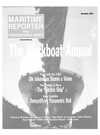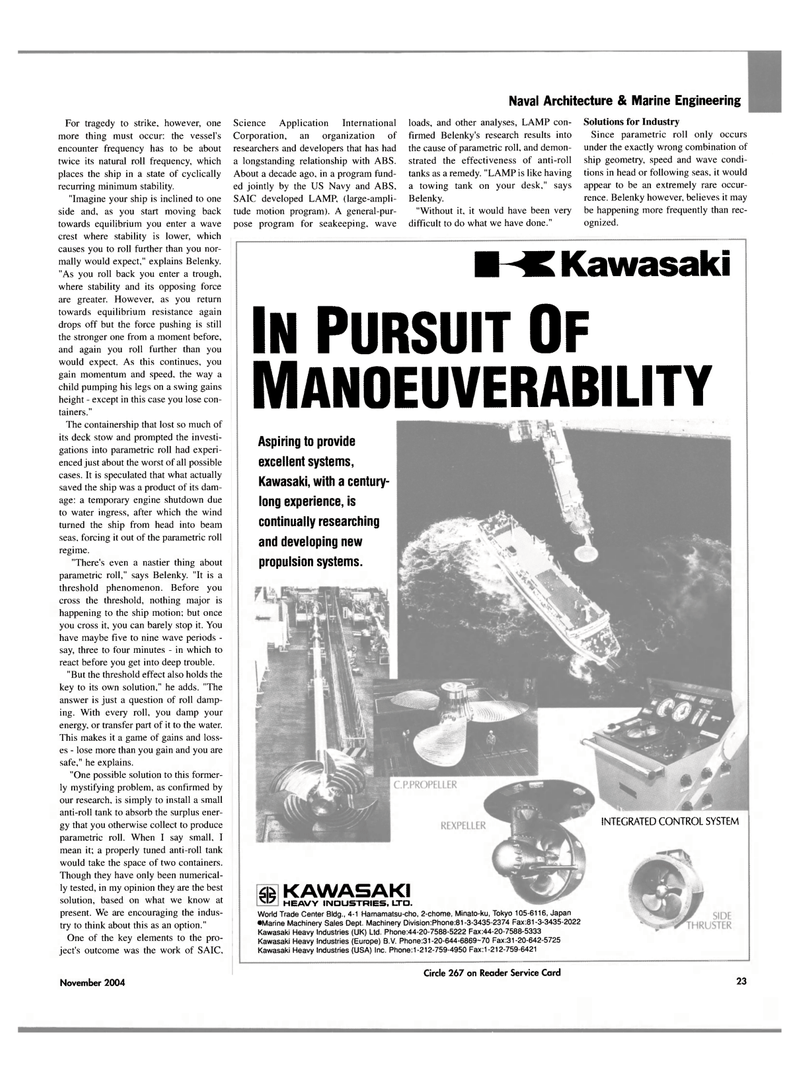
Page 23: of Maritime Reporter Magazine (November 2004)
The Workboat Annual
Read this page in Pdf, Flash or Html5 edition of November 2004 Maritime Reporter Magazine
Naval Architecture & Marine Engineering
For tragedy to strike, however, one more thing must occur: the vessel's encounter frequency has to be about twice its natural roll frequency, which places the ship in a state of cyclically recurring minimum stability. "Imagine your ship is inclined to one side and, as you start moving back towards equilibrium you enter a wave crest where stability is lower, which causes you to roll further than you nor- mally would expect," explains Belenky. "As you roll back you enter a trough, where stability and its opposing force are greater. However, as you return towards equilibrium resistance again drops off but the force pushing is still the stronger one from a moment before, and again you roll further than you would expect. As this continues, you gain momentum and speed, the way a child pumping his legs on a swing gains height - except in this case you lose con- tainers."
The containership that lost so much of its deck stow and prompted the investi- gations into parametric roll had experi- enced just about the worst of all possible cases. It is speculated that what actually saved the ship was a product of its dam- age: a temporary engine shutdown due to water ingress, after which the wind turned the ship from head into beam seas, forcing it out of the parametric roll regime. "There's even a nastier thing about parametric roll," says Belenky. "It is a threshold phenomenon. Before you cross the threshold, nothing major is happening to the ship motion: but once you cross it, you can barely stop it. You have maybe five to nine wave periods - say, three to four minutes - in which to react before you get into deep trouble. "But the threshold effect also holds the key to its own solution," he adds. "The answer is just a question of roll damp- ing. With every roll, you damp your energy, or transfer part of it to the water.
This makes it a game of gains and loss- es - lose more than you gain and you are safe," he explains. "One possible solution to this former- ly mystifying problem, as confirmed by our research, is simply to install a small anti-roll tank to absorb the surplus ener- gy that you otherwise collect to produce parametric roll. When I say small, I mean it; a properly tuned anti-roll tank would take the space of two containers.
Though they have only been numerical- ly tested, in my opinion they are the best solution, based on what we know at present. We are encouraging the indus- try to think about this as an option."
One of the key elements to the pro- ject's outcome was the work of SAIC,
November 2004
Science Application International
Corporation, an organization of researchers and developers that has had a longstanding relationship with ABS.
About a decade ago, in a program fund- ed jointly by the US Navy and ABS,
SAIC developed LAMP, (large-ampli- tude motion program). A general-pur- pose program for seakeeping, wave loads, and other analyses, LAMP con- firmed Belenky's research results into the cause of parametric roll, and demon- strated the effectiveness of anti-roll tanks as a remedy. "LAMP is like having a towing tank on your desk," says
Belenky. "Without it, it would have been very difficult to do what we have done."
Solutions for Industry
Since parametric roll only occurs under the exactly wrong combination of ship geometry, speed and wave condi- tions in head or following seas, it would appear to be an extremely rare occur- rence. Belenky however, believes it may be happening more frequently than rec- ognized.
Circle 267 on Reader Service Card 23 $
IHC Kawasaki
IN PURSUIT OF
MANOEUVERABILITY excellent systems,
Kawasaki, with a century- long experience, is continually researching and developing new propulsion systems.
INTEGRATED CONTROL SYSTEM
Aspiring to provide
KAWASAKI
HEAVY INDUSTRIES, LTD.
World Trade Center Bldg., 4-1 Hamamatsu-cho, 2-chome, Minato-ku, Tokyo 105-6116, Japan •Marine Machinery Sales Dept. Machinery Division:Phone:81 -3-3435-2374 Fax:81-3-3435-2022
Kawasaki Heavy Industries (UK) Ltd. Phone:44-20-7588-5222 Fax:44-20-7588-5333
Kawasaki Heavy Industries (Europe) B.V. Phone:31-20-644-6869-70 Fax:31-20-642-5725
Kawasaki Heavy Industries (USA) Inc. Phone:1-212-759-4950 Fax:1-212-759-6421

 22
22

 24
24
